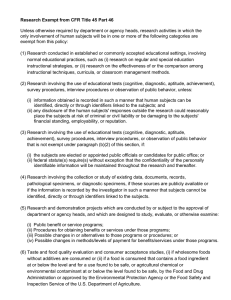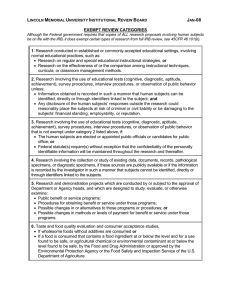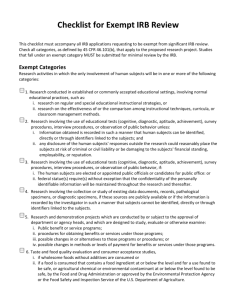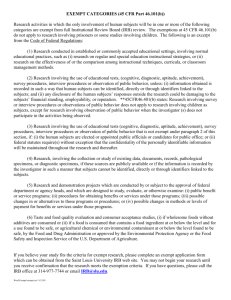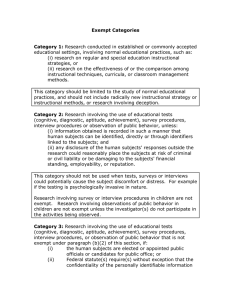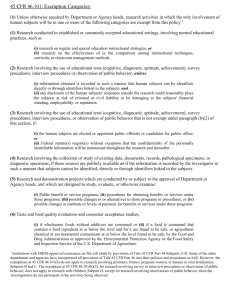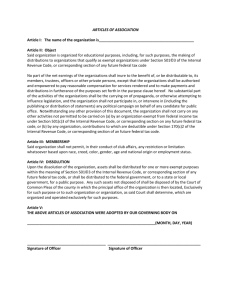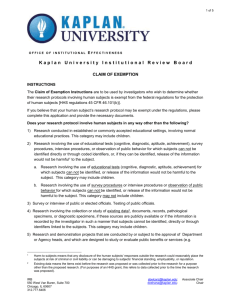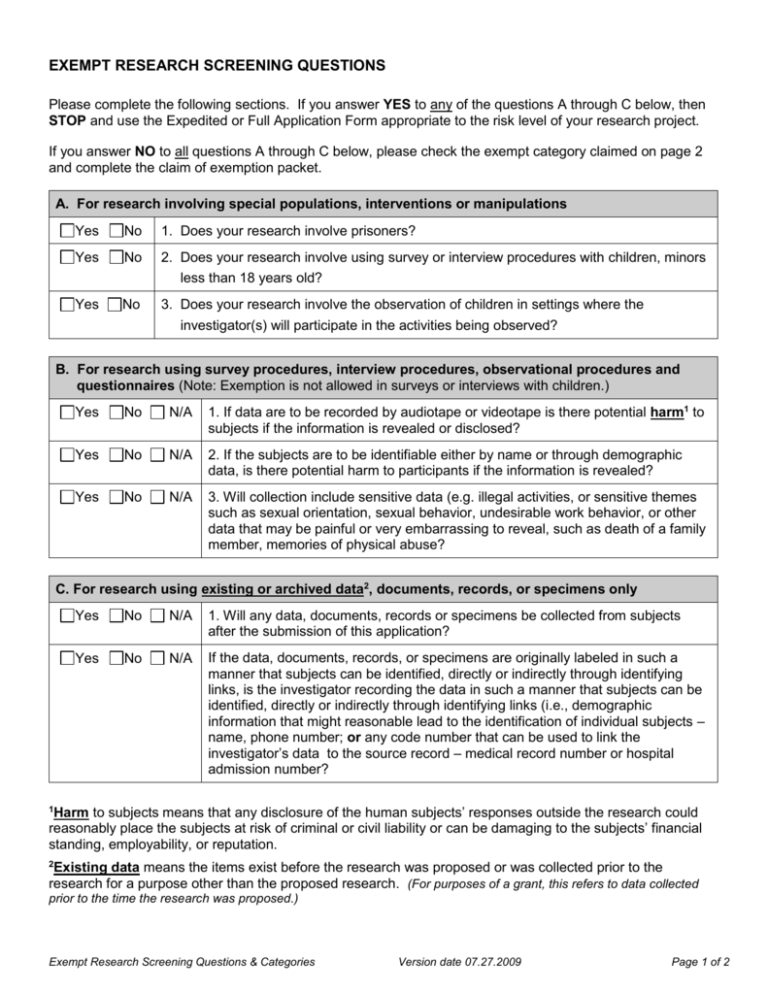
EXEMPT RESEARCH SCREENING QUESTIONS
Please complete the following sections. If you answer YES to any of the questions A through C below, then
STOP and use the Expedited or Full Application Form appropriate to the risk level of your research project.
If you answer NO to all questions A through C below, please check the exempt category claimed on page 2
and complete the claim of exemption packet.
A. For research involving special populations, interventions or manipulations
Yes
No
1. Does your research involve prisoners?
Yes
No
2. Does your research involve using survey or interview procedures with children, minors
less than 18 years old?
Yes
No
3. Does your research involve the observation of children in settings where the
investigator(s) will participate in the activities being observed?
B. For research using survey procedures, interview procedures, observational procedures and
questionnaires (Note: Exemption is not allowed in surveys or interviews with children.)
Yes
No
N/A
1. If data are to be recorded by audiotape or videotape is there potential harm1 to
subjects if the information is revealed or disclosed?
Yes
No
N/A
2. If the subjects are to be identifiable either by name or through demographic
data, is there potential harm to participants if the information is revealed?
Yes
No
N/A
3. Will collection include sensitive data (e.g. illegal activities, or sensitive themes
such as sexual orientation, sexual behavior, undesirable work behavior, or other
data that may be painful or very embarrassing to reveal, such as death of a family
member, memories of physical abuse?
C. For research using existing or archived data2, documents, records, or specimens only
Yes
No
N/A
1. Will any data, documents, records or specimens be collected from subjects
after the submission of this application?
Yes
No
N/A
If the data, documents, records, or specimens are originally labeled in such a
manner that subjects can be identified, directly or indirectly through identifying
links, is the investigator recording the data in such a manner that subjects can be
identified, directly or indirectly through identifying links (i.e., demographic
information that might reasonable lead to the identification of individual subjects –
name, phone number; or any code number that can be used to link the
investigator’s data to the source record – medical record number or hospital
admission number?
Harm to subjects means that any disclosure of the human subjects’ responses outside the research could
reasonably place the subjects at risk of criminal or civil liability or can be damaging to the subjects’ financial
standing, employability, or reputation.
1
2
Existing data means the items exist before the research was proposed or was collected prior to the
research for a purpose other than the proposed research. (For purposes of a grant, this refers to data collected
prior to the time the research was proposed.)
Exempt Research Screening Questions & Categories
Version date 07.27.2009
Page 1 of 2
EXEMPT RESEARCH CATEGORY CLAIMED
(According to OPRR Reports, Title 45, CFR 46, rev. June 18, 1991) Please identify all that apply to your
research by checking applicable boxes.
1.
2.
Research conducted in established or commonly accepted educational settings, involving normal educational
practices, such as (i) research on regular and special education instructional strategies, or (ii) research on the
effectiveness of or the comparison among instructional techniques, curricular or classroom management
methods. This category may include children.
Research involving the use of educational tests (cognitive, diagnostic, aptitude, achievement), survey
procedures, interview procedures or observation of public behavior, unless: (i) information obtained is
recorded in such a manner that human subjects can be identified, directly or through identifiers linked to the
subjects; and (ii) any disclosure of the human subjects’ responses outside the research could reasonably
place the subjects at risk of criminal or civil liability or be damaging to the subjects’ financial standing,
employment or reputation. Research which deals with sensitive aspects of the subject’s own behavior such
as illegal conduct, drug use, sexual behavior, or use of alcohol, cannot be exempt from review.
2a
Research involving the use of educational tests (cognitive, diagnostic, aptitude, achievement)
in which subjects can not be identified or release of the information would not harm1 the
subject. This category may include children.
2b
Research involving the use of survey procedures or interview procedures or observation of
public behavior for which subjects can not be identified, or release of the information would
not harm the subject. This category may include children but only for the observation of public
behavior and only when the investigators do not participate in the activity being observed.
3.
Research involving the use of educational tests (cognitive, diagnostic, aptitude, achievement), survey
procedures, interview procedures, or observation of public behavior that is not exempt under paragraph (b)
(2) of this section if (i) the human subjects are elected or appointed public officials or candidates for public
office; or (ii) federal statue(s) require(s) without exception that the confidentiality of the personally identifiable
information will be maintained throughout the research and thereafter. Research which deals with sensitive
aspects of the subject’s own behavior such as illegal conduct, drug use, sexual behavior, or use of alcohol,
cannot be exempt from review.
4.
Research involving the collection or study of existing data2, documents, records, pathological specimens, or
diagnostic specimens, if these sources are publicly available or if the information is recorded by the
investigator in such a manner that subjects cannot be identified, directly or through identifiers linked to the
subjects. This category may include children.
5.
Research and demonstration projects which are conducted by or subject to the approval of federal
department or agency heads and which are designed to study, evaluate, or otherwise examine: (i) public
benefit or service programs; (ii) procedures for obtaining benefits or services under those programs; (iii)
possible changes in or alternatives to those programs or procedures; or (iv) possible changes in methods or
levels of payment for benefits or services under those programs. This category may include children.
6.
Taste and food quality evaluation and consumer acceptance studies, (i) if wholesome foods without additives
are consumed or (ii) if a food is consumed that contains a food ingredient at or below the level and for a use
found to be safe, or agricultural chemical or environmental contaminant at or below the level found to be safe,
by the U.S. Food and Drug Administration or approved by the Environmental Protection Agency or the Food
and Safety and Inspection Service of the U.S. Department of Agriculture. This category may include children.
Harm to subjects means that any disclosure of the human subjects’ responses outside the research could reasonably
place the subjects at risk of criminal or civil liability or can be damaging to subjects’ financial standing, employability, or
reputation.
2
Existing data means the items exist before the research was proposed or was collected prior to the research for a
purpose other than the proposed research. (For purposes of a grant, this refers to data collected prior to the time the
research was proposed.)
1
Exempt Research Screening Questions & Categories
Version date 07.27.2009
Page 2 of 2

